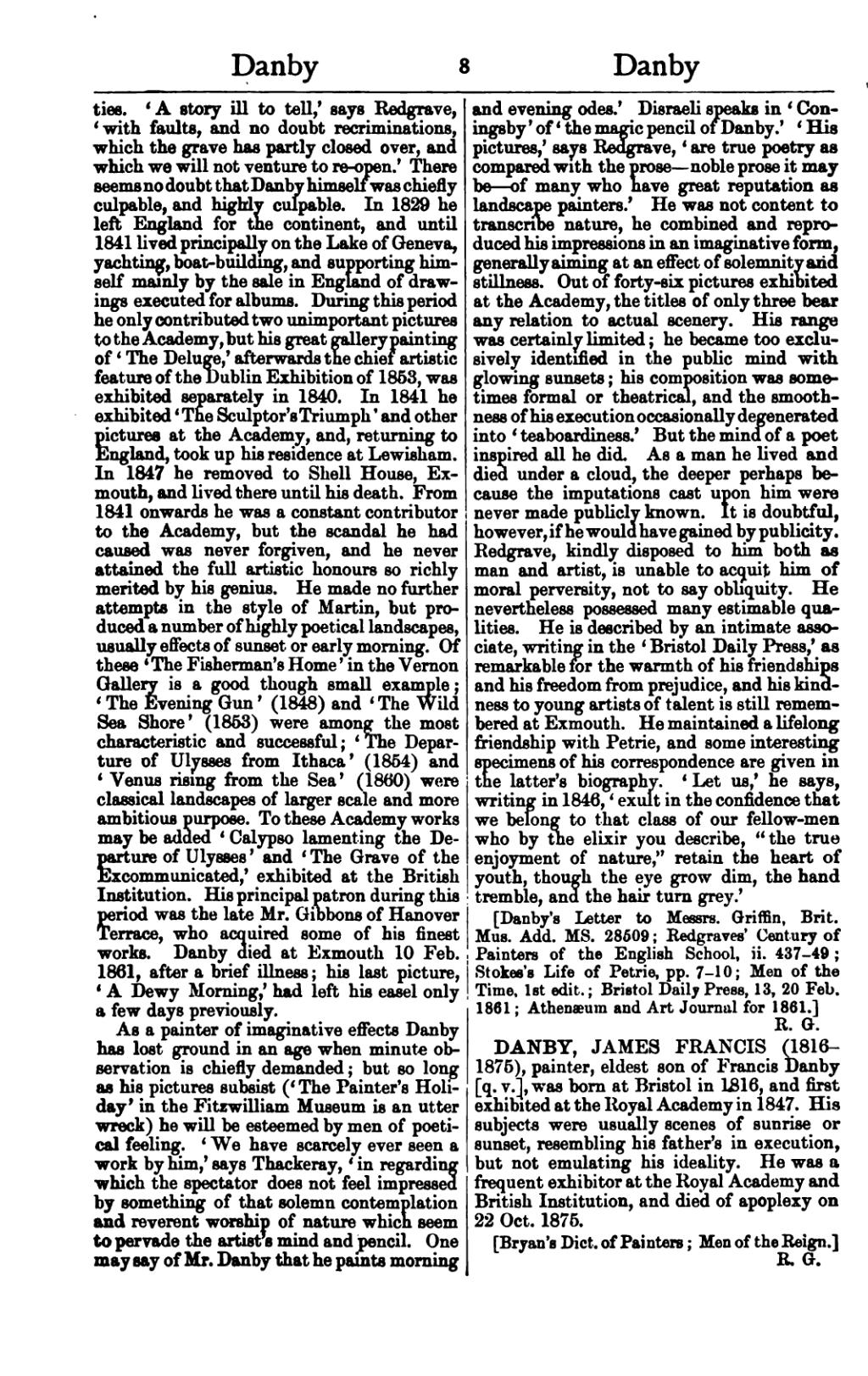ties. ‘A story ill to tell,’ says Redgrave, ‘with faults, and no doubt recriminations, which the grave has partly closed over, and which we will not venture to re-open.’ There seems no doubt that Danby himself was chiefly culpable, and highly culpable. In 1829 he left England for the continent, and until 1841 lived principally on the Lake of Geneva, yachting, boat-building, and supporting himself mainly by the sale in England of drawings executed for albums. During this period he only contributed two unimportant pictures to the Academy, but his great gallery painting of ‘The Deluge,’ afterwards the chief artistic feature of the Dublin Exhibition of 1853, was exhibited separately in 1840. In 1841 he exhibited ‘The Sculptor's Triumph’ and other pictures at the Academy, and, returning to England, took up his residence at Lewisham. In 1847 he removed to Shell House, Exmouth, and lived there until his death. From 1841 onwards he was a constant contributor to the Academy, but the scandal he had caused was never forgiven, and he never attained the full artistic honours so richly merited by his genius. He made no further attempts in the style of Martin, but produced a number of highly poetical landscapes, usually effects of sunset or early morning. Of these ‘The Fisherman's Home’ in the Vernon Gallery is a good though small example; ‘The Evening Gun’ (1848) and ‘The Wild Sea Shore’ (1853) were among the most characteristic and successful; ‘The Departure of Ulysses from Ithaca’ (1854) and ‘Venus rising from the Sea’ (1860) were classical landscapes of larger scale and more ambitious purpose. To these Academy works may be added ‘Calypso lamenting the Departure of Ulysses’ and ‘The Grave of the Excommunicated,’ exhibited at the British Institution. His principal patron during this period was the late Mr. Gibbons of Hanover Terrace, who acquired some of his finest works. Danby died at Exmouth 10 Feb. 1861, after a brief illness; his last picture, ‘A Dewy Morning,’ had left his easel only a few days previously. As a painter of imaginative effects Danby has lost ground in an age when minute observation is chiefly demanded; but so long as his pictures subsist (‘The Painter's Holiday’ in the Fitzwilliam Museum is an utter wreck) he will be esteemed by men of poetical feeling. ‘We have scarcely ever seen a work by him,’ says Thackeray, ‘in regarding which the spectator does not feel impressed by something of that solemn contemplation and reverent worship of nature which seem to pervade the artist's mind and pencil. One may say of Mr. Danby that he paints morning and evening odes.’ Disraeli speaks in ‘Coningsby’ of ‘the magic pencil of Danby.’ ‘His pictures,’ says Redgrave, ‘are true poetry as compared with the prose—noble prose it may be—of many who have great reputation as landscape painters.’ He was not content to transcribe nature, he combined and reproduced his impressions in an imaginative form, generally aiming at an effect of solemnity and stillness. Out of forty-six pictures exhibited at the Academy, the titles of only three bear any relation to actual scenery. His range was certainly limited; he became too exclusively identified in the public mind with glowing sunsets; his composition was sometimes formal or theatrical, and the smoothness of his execution occasionally degenerated into ‘teaboardiness.’ But the mind of a poet inspired all he did. As a man he lived and died under a cloud, the deeper perhaps because the imputations cast upon him were never made publicly known. It is doubtful, however, if he would have gained by publicity. Redgrave, kindly disposed to him both as man and artist, is unable to acquit him of moral perversity, not to say obliquity. He nevertheless possessed many estimable qualities. He is described by an intimate associate, writing in the ‘Bristol Daily Press,’ as remarkable for the warmth of his friendships and his freedom from prejudice, and his kindness to young artists of talent is still remembered at Exmouth. He maintained a lifelong friendship with Petrie, and some interesting specimens of his correspondence are given in the latter's biography. ‘Let us,’ he says, writing in 1846, ‘exult in the confidence that we belong to that class of our fellow-men who by the elixir you describe, “the true enjoyment of nature,” retain the heart of youth, though the eye grow dim, the hand tremble, and the hair turn grey.’
[Danby's Letter to Messrs. Griffin, Brit. Mus. Add. MS. 28509; Redgraves' Century of Painters of the English School, ii. 437–49; Stokes's Life of Petrie, pp. 7–10; Men of the Time, 1st edit.; Bristol Daily Press, 13, 20 Feb. 1861; Athenæum and Art Journal for 1861.]
DANBY, JAMES FRANCIS (1816–1875), painter, eldest son of Francis Danby [q. v.], was born at Bristol in 1816, and first exhibited at the Royal Academy in 1847. His subjects were usually scenes of sunrise or sunset, resembling his father's in execution, but not emulating his ideality. He was a frequent exhibitor at the Royal Academy and British Institution, and died of apoplexy on 22 Oct. 1875.
[Bryan's Dict. of Painters; Men of the Reign.]
